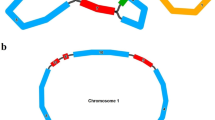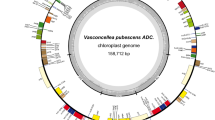Abstract
The complete nucleotide sequence of the chloroplast genome of sugarcane (Saccharum officinarum) was determined. It consists of 141,182 base-pairs (bp), containing a pair of inverted repeat regions (IRA, IRB) of 22,794 bp each. The IRA and IRB sequences separate a small single copy region (12,546 bp) and a large single copy (83,048 bp) region. The gene content and relative arrangement of the 116 identified genes (82 peptide-encoding genes, four ribosomal RNA genes, 30 tRNA genes), with the 16 ycf genes, are highly similar to maize. Editing events, defined as C-to-U transitions in the mRNA sequences, were comparable with those observed in maize, rice and wheat. The conservation of gene organization and mRNA editing suggests a common ancestor for the sugarcane and maize plastomes. These data provide the basis for functional analysis of plastid genes and plastid metabolism within the Poaceae. The sugarcane chloroplast DNA sequence is available at GenBank under accession NC005878.



Similar content being viewed by others
References
Al-Janabi SM, McClelland M, Petersen C, Sobral BW (1994) Phylogenetic analysis of organellar DNA sequences in the Andropogoneae: Saccharinae. Theor Appl Genet 88:933–944
Altschul SF, Gish W, Miller W, Myers EW, Lipman DJ (1990) Basic local alignment search tool. J Mol Biol 215:403–410
Asano T, Tsudzuki T, Takahashi S, Shimada H, Kadowaki K (2004) Complete nucleotide sequence of the sugarcane (Saccharum officinarum) chloroplast genome: a comparative analysis of four monocot chloroplast genomes. DNA Res 11:93–99
Barker NP, Linder HP, Harley EH (1995) Polyphyly of Arundinoideae (Poaceae)—evidence from rbcL sequence data. Syst Bot 20:423–435
Barker NP, Linder HP, Harley EH (1998) Sequences of the grass-specific insert in the chloroplast rpoC2 gene elucidates generic relationships of the Arundinoideae (Poaceae). Syst Bot 23:327–350
Bendich AJ (2004) Circular chloroplast chromosomes: the grand illusion. Plant Cell 16:1661–1666
Bock R (1998) Analysis of RNA editing in plastids. Methods Enzymol 15:75–83
Bock R (2000) Sense from nonsense: how the genetic information of chloroplasts is altered by RNA editing. Biochimie 82:549–557
Bock R (2001) Transgenic plastids in basic research and plant biotechnology. J Mol Biol 312:425–438
Bock R (2004) Studying RNA editing in transgenic chloroplasts of higher plants. Methods Mol Biol 265:345–56
Bock R, Kan MS (2004) Taming plastids for a green future. Trends Biotechnol 22:311–318
Corneille S, Lutz K, Maliga P (2000) Conservation of RNA editing between rice and maize plastids: are most editing events dispensable? Mol Gen Genet 264:419–424
D’Hont A, Paulet F, Glaszmann JC (2002) Oligoclonal interspecific origin of ‘North Indian’ and ‘Chinese’ sugarcanes. Chromosome Res 10:253–262
Delcher AL, Harmon D, Kasif S, White O, Salzberg SL (1999) Improved microbial gene identification with GLIMMER. Nucleic Acids Res 27:4636–4641
Drescher A, Ruf S, Calsa T Jr, Carrer H, Bock R (2000) The two largest chloroplast genome-encoded open reading frames of higher plants are essential genes. Plant J 22:97–104
Drescher A, Hupfer H, Nickel C, Albertazzi F, Hohmann U, Herrmann RG, Maier RM (2002) C-to-U conversion in the intercistronic ndhI/ndhG RNA of plastids from monocot plants: conventional editing in an unconventional small reading frame? Mol Genet Genomics 267:262–269
Ewing B, Green P (1998) Base-calling of automated sequencer traces using phred. II. Error probabilities. Genome Res 8:186–194
Ewing B, Hillier L, Wendl MC, Green P (1998) Base-calling of automated sequencer traces using phred. I. Accuracy assessment. Genome Res 8:175–185
Fiebig A, Stegemann S, Bock R (2004) Rapid evolution of RNA editing sites in a small non-essential plastid gene. Nucleic Acids Res 32:3615–3622
Freyer R, Lopez, C, Maier RM, Martin M, Sabater B, Kossel H (1995) Editing of the chloroplast ndhB encoded transcript shows divergence between closely related members of the grass family (Poaceae). Plant Mol Biol 29:679–684
Gordon D, Abajian C, Green P (1998) Consed: a graphical tool for sequence finishing. Genome Res 8:195–202
Grivet L, Arruda P (2002) Sugarcane genomics: depicting the complex genome of an important tropical crop. Curr Opin Plant Biol 5:122–127
Halter CP, Peeters NM, Hanson MR (2004) RNA editing in ribosome-less plastids of iojap maize. Curr Genet 45:331–337
Hiratsuka J, Shimada H, Whittier R, Ishibashi T, Sakamoto M, Mori M, Kondo C, Honji Y, Sun C, Meng B, Li Y, Kanno A, Nishizawa Y, Hirai A, Shinozaki K, Sugiura M (1989) The complete sequence of the rice (Oryza sativa) chloroplast genome: intermolecular recombination between distinct tRNA genes accounts for a major plastid DNA inversion during the evolution of the cereals. Mol Gen Genet 217:185–194
Hirose T, Kusumegi T, Tsudzuki T, Sugiura M (1999) RNA editing sites in tobacco chloroplast transcripts: editing as a possible regulator of chloroplast RNA polymerase activity. Mol Gen Genet 262:462–467
Hoch B, Maier RM, Appel K, Igloi G, Kossel H (1991) Editing of a chloroplast mRNA by creation of an initiation codon. Nature 353:178–180
Howe CJ, Barker RF, Bowman CM, Dyer TA (1988) Common features of three inversions in wheat chloroplast DNA. Curr Genet 13:343–349
Karcher D, Bock R (2002) Temperature sensitivity of RNA editing and intron splicing reactions in the plastid ndhB transcript. Curr Genet 41:48–52
Katayama H, Ogihara Y (1996) Phylogenetic affinities of the grasses to other monocots as revealed by molecular analysis of chloroplast DNA. Curr Genet 29:572–581
Kato T, Kaneko T, Sato S, Nakamura Y, Tabata S (2000) Complete structure of the chloroplast genome of a legume, Lotus japonicus. DNA Res 7:323–330
Lilly JW, Havey MJ, Jackson SA, Jiang J (2001) Cytogenomic analyses reveal the structural plasticity of the chloroplast genome in higher plants. Plant Cell 13:245–254
Lowe TM, Eddy SR (1997) tRNAscan-SE: a program for improved detection of transfer RNA genes in genomic sequence. Nucleic Acids Res 25:955–964
Maier RM, Neckermann K, Igloi GL, Kossel H (1995) Complete sequence of the maize chloroplast genome: gene content, hotspots of divergence and fine tuning of genetic information by transcript editing. J Mol Biol 251:614–628
Maliga P (2003) Progress towards commercialization of plastid transformation technology. Trends Biotechnol 21:20–28
Maliga P (2004) Plastid transformation of higher plants. Annu Rev Plant Biol 55:289–313
Mariac C, Trouslot P, Poteaux C, Bezançon G, Renno JF (2000) Chloroplast DNA extraction from herbaceous and woody plants for direct restriction fragment length polymorphism analysis. Biotechniques 28:110–113
Matsuoka Y, Yamazaki Y, Ogihara Y, Tsunewaki K (2002) Whole chloroplast genome comparison of rice, maize, and wheat: implications for chloroplast gene diversification and phylogeny of cereals. Mol Biol Evol 19:2084–2091
Miyamoto T, Obokata J, Sugiura M (2004) A site-specific factor interacts directly with its cognate RNA editing site in chloroplast transcripts. Proc Natl Acad Sci USA 101:48–52
Mulligan RM, Williams MA, Shanahan MT (1999) RNA editing site recognition in higher plant mitochondria. J Hered 90:338–344
Ogihara Y, Terachi T, Sasakuma T (1988) Intramolecular recombination of chloroplast genome mediated by short direct-repeat sequences in wheat species. Proc Natl Acad Sci USA 85:8573–8577
Ogihara Y, Terachi T, Sasakuma T (1991) Molecular analysis of the hot spot region related to length mutations in wheat chloroplast DNAs. I. Nucleotide divergence of genes and intergenic spacer regions located in the hot spot region. Genetics 129:873–884
Ogihara Y, Isono K, Kojima T, Endo A, Hanaoka M, Shiina T, Terachi T, Utsugi S, Murata M, Mori N, Takumi S, Ikeo K, Gojobori T, Murai R, Murai K, Matsuoka Y, Ohnishi Y, Tajiri H, Tsunewaki K (2002) Structural features of a wheat plastome as revealed by complete sequencing of chloroplast DNA. Mol Genet Genomics 266:740–746
Palmer JD (1992) Cell organelles. In: Herrmann RG (ed) Plant gene research. Springer, Berlin Heidelberg New York, pp 99–122
Palmer JD, Stein DB (1986) Conservation of chloroplast genome structure among vascular plants. Curr Genet 10:823–833
Peeters NM, Hanson MR (2002) Transcript abundance supercedes editing efficiency as a factor in developmental variation of chloroplast gene expression. RNA 8:497–511
Pyke KA (1999) Plastid division and development. Plant Cell 11:549–556
Reverdatto SV, Andreeva AV, Buryakova AA, Chakhmakhcheva OG, Efimov VA (1989) Nucleotide sequence of the barley chloroplast psbC gene. Nucleic Acids Res17:3996
Roach BT, Daniels J (1987) A review of the origin and improvement of sugarcane. In: Copersucar (ed) Copersucar international sugarcane breeding workshop. Copersucar, Piracicaba
Rowan B, Oldenburg DJ, Bendich AJ (2004) The demise of chloroplast DNA in Arabidopsis. Curr Genet 46:176–181
Ruf S, Hermann M, Berger IJ, Carrer H, Bock R (2001) Stable genetic transformation of tomato plastids and expression of a foreign protein in fruit. Nat Biotechnol 19:870–875
Sasaki T, Yukawa Y, Miyamoto T, Obokata J, Sugiura M (2003) Identification of RNA editing sites in chloroplast transcripts from the maternal and paternal progenitors of tobacco (Nicotiana tabacum): comparative analysis shows the involvement of distinct trans-factors for ndhB editing. Mol Biol Evol 20:1028–1035
Schmitz-Linneweber C, Regel R, Du TG, Hupfer H, Herrmann R, Maier RM (2002) The palstid chromossome of Atropa belladonna and its comparison with that of Nicotiana tabacum: the role of RNA editing in generating divergence in the process of plant speciation. Mol Biol Evol 19:1602–1612
Shimada H, Sugiura M (1991) Fine structural features of the chloroplast genome: comparison of the sequenced chloroplast genomes. Nucleic Acids Res 19:983–995
Sobral BWS, Braga DPV, Lahood ES, Keim P (1994) Phylogenetic analysis of chloroplast restriction enzyme site mutations in the Saccharinae Griseb, subtribe of the Andropogoneae Dumort tribe. Theor Appl Genet 87:843–853
Sugiura M (2003) History of chloroplast genomics. Photosynth Res 76:371–377
Tatusova TA, Madden TL (1999) BLAST 2 sequences, a new tool for comparing protein and nucleotide sequences. FEMS Microb Lett 174:247–250
Tsudzuki T, Wakasugi T, Sugiura M (2001) Comparative analysis of RNA editing sites in higher plant chloroplasts. J Mol Evol 53:327–332
Vettore AL, Silva FR, Kemper EL, Souza GM, Silva AM, Ferro MIT, Silva FH, Giglioti EA, Lemos MVF, Coutinho LL, Nobrega MP, Carrer H, França SC, Bacci Junior M, Goldman MHS, Gomes SL, Nunes LR, Camargo LEA, Siqueira WJ, Sluys MV, Thiemann OH, Kuramae EE, Santelli RV, Marino CL, Targon MLPN, Ferro JA, Silveira HCS, Marini D, Lemos EGM, Monteiro-Vitorello CB, Tambor JHM, Carraro DM, Roberto PG, Martins VG, Goldman GH, Oliveira RC, Truffi D, Colombo CA, Rossi M, Araujo PG, Sculaccio SA, Angella A, Lima MMA, Rosa VE Jr, Siviero F, Coscrato VE, Machado MA, Grivet L, Di Mauro SMZ, Nobrega FG, Menck CFM, Braga MDV, Telles GP, Cara FAA, Pedrosa G, Meidanis J, Arruda P (2003) Analysis and functional annotation of an expressed sequence tag collection for tropical crop sugarcane. Genome Res 13:2725–2735
Wakasugi T, Hirose T, Horihata M, Tsudzuki T, Kossel H, Sugiura M (1996) Creation of a novel protein-coding region at the RNA level in black pine chloroplasts: the pattern of RNA editing in the gymnosperm chloroplast is different from that in angiosperms. Proc Natl Acad Sci USA 93:8766–8770
Wilson MA, Gaut B, Clegg MT (1990) Chloroplast DNA evolves slowly in the palm family (Arecaceae). Mol Biol Evol 7:303–314
Acknowledgements
The authors gratefully acknowledge Eugênio Cesar Ulian and William Lee Burnquist (Copersucar Technology Center, Piracicaba, São Paulo, Brazil) for supplying the sugarcane commercial hybrid SP 80-3280, Ralph Bock, Stephanie Ruf and Martin Hager for suggestions on sugarcane plastid DNA isolation, the Fundação de Amparo à Pesquisa do Estado de São Paulo (FAPESP) for project grant 99/02860-8 and for fellowships granted to T.C.J. (99/02973-7) and D.M.C. (98/06206-8) and the Conselho Nacional de Pesquisa e Desenvolvimento (CNPq/PIBIC) for a fellowship granted to M.R.B. The authors declare that this work was carried out in compliance with the current laws governing genetic experimentation in Brazil.
Author information
Authors and Affiliations
Corresponding author
Additional information
Communicated by A. Brennicke
Rights and permissions
About this article
Cite this article
Calsa Júnior, T., Carraro, D.M., Benatti, M.R. et al. Structural features and transcript-editing analysis of sugarcane (Saccharum officinarum L.) chloroplast genome. Curr Genet 46, 366–373 (2004). https://doi.org/10.1007/s00294-004-0542-4
Received:
Revised:
Accepted:
Published:
Issue Date:
DOI: https://doi.org/10.1007/s00294-004-0542-4




